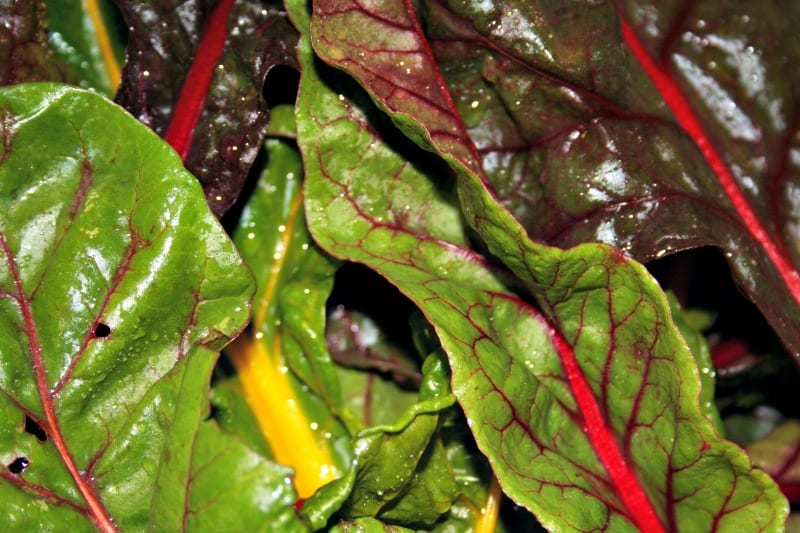Growing Swiss chard in the home garden offers many benefits. Chard is one of the few vegetables you can plant from seed in the spring and enjoy until the first frost. Sometimes Swiss chard overwinters and survives to the following spring. It’s a nutritious, underrated vegetable that offers so much for so little.
Growing Swiss Chard
Growing Swiss chard requires full sun and average soil. Notice that the soil needn’t be perfect; Swiss chard tolerates many soil conditions.
Swiss chard is always started from seeds. You plant the seeds directly into the garden soil. They should be planted in the early spring about two to three weeks before the last frost. If you can work the soil and the soil is not soaking wet from rain or melted snow, it is fine to plant your Swiss chard seeds.
Swiss chard seeds should be planted about 1/2 inch to 3/4 of an inch deep. You can space them several inches apart and thin them out later.
Mix a little 5-10-10 garden fertilizer into the soil at planting time. Water them well and keep the seeds moist until they sprout.
Harvesting Chard
Swiss chard can be eaten at almost any point during its growth. Leave a few inches of leaves on the plants at all times. Plants produce their own food through photosynthesis, which occurs in the leaves. If you cut off too many leaves, you may not leave the plant with enough leaves to survive.
To harvest your Swiss chard, wait until the leaves are four to five inches tall. Take a pair of sharp scissors and a bowl to the garden. Snip the leaves off at ground level or an inch or two above ground level. Place each leaf in the bowl. When you bring the leaves inside, rinse them thoroughly under cool, running water.
When you bring the leaves inside, rinse them thoroughly under cool, running water. You’ll find an assortment of hitchhikers aboard the leaves, so be wary: spiders, earwigs, slugs, the occasional beetle hides in Swiss chard. Please don’t let this deter you from enjoying your Swiss chard. My dad used to say they added extra protein!
Varieties of Swiss Chard to Grow
I love growing a variety of Swiss chard called “Rainbow.” It is so pretty growing in the garden that you won’t want to cut it! The stems are indeed a rainbow of colors. The leaves reflect the colors, too.
In one bowl, you will find ruby red, bright chartreuse, and a wide range of colors in between. This was my weekend harvest:
Be warned that when you cook Swiss chard, the leaves “bleed” color into the water or oil. It will look like beets or some peculiar massacre has happened in the kitchen.
“Bright Lights” is another popular colorful variety. I have grown both “Rainbow” and “Bright Lights” successfully in zones 6 and 7.
I have tried to grow “Fordhook Giant” and “Lucullus” in Virginia and they did not do well. I don’t know if it was the quality of the seeds or the particular variety – but they didn’t really germinate well, and they struggled in the heat.
Varieties to try include:
- Bright Lights
- Fordhook Giant
- Large White Ribbed
- Lucullus
- Rainbow
- Rhubarb (not to be confused with the vegetable Rhubarb)
- Ruby Red
Cooking with Swiss Chard: The Basics
Here’s the bad news: to get enough Swiss chard for four servings, you will need an enormous amount of chard. Like spinach, chard cooks down from a big pile into what seems to be nothing. Be warned! Growing Swiss chard means growing quite a lot of it to get enough to enjoy.
After harvesting and cleaning the chard, you’ll need to remove the hard rib stem and ribbon the leaves. I set up a cutting board and make two slices, one on either side of the ribs to separate out the leaves. A sharp knife helps me slice the leaves into ribbons.
The ribbons can then be boiled for about five minutes, drained, salted and enjoyed. I prefer to cook Swiss chard by sauteeing it in good-quality olive oil with a diced clove of garlic or two and a sprinkle of salt and pepper. Some cooks add onion. I sometimes toss in canned beans and a bit of Parmesan for a meal.
Here’s my favorite Swiss Chard Recipe.
Swiss chard is rich in fiber, vitamins, minerals and anti-oxidants. One cup of boiled Swiss chard contains:
- 35 calories
- 636% of your daily allowance of vitamin K
- 60% of your vitamin A needs
- 42% of vitamin C
- Minerals such as magnesium, copper, manganese
- Iron
- Potassium
- Choline
- Zinc
- An assortment of B vitamins
With a low glycemic index, and plentiful nutrients, and a very easy-going habit, growing Swiss chard may be a “must” on your list of vegetables for the home garden.
Happy gardening. Keep growing!







A lovely plant! Happy Thursday♥